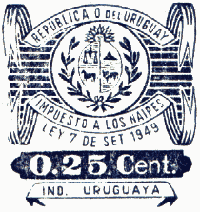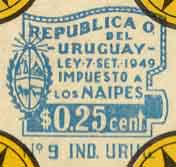Uruguay playing card tax
In 1806 the Council of Concepción del Uruguay imposed an 8 Peso tax on card and billiard tables on account of “the detrimental effect on poor and innocent people”

Uruguay playing card tax - Impuesto Sobre Naipes
In 1806 the Council of Concepción del Uruguay imposed an 8 Peso tax on card and billiard tables on account of "the detrimental effect on poor and innocent people". During the 19th century various import tariffs were applied to playing cards. After February 1919 tax on playing cards was controlled by tax stamps on the cards and tax bands outside the wrappers, according to the following laws:
Leyes Nros. 6,874 y 6,894 de 11 & 27 de Febrero de 1919.
A) Impuesto sobre barajas de producción nacional = 12 centésimos [blue tax stamp]
B) Impuesto sobre barajas de importación = 22 centésimos [yellow tax stamp]
Ley Nº 11,326, Montevideo, 7 de setiembre de 1949.
Artículo 12. El impuesto interno a los naipes, establecido por las leyes Nros. 6.874 y 6.894, de 11 y 27 de febrero de 1919, será percibido de acuerdo a la siguiente escala:
A) Naipes nacionales: cada mazo = $ 0.25
B) Naipes importados: cada mazo = $ 0.60
Los naipes importados que se vendan al público a un precio superior a $ 1.50 pagarán el impuesto a razón de $ 0.25 por cada $ 0.50 o fracción del precio de venta.
El Poder Ejecutivo reglamentará la forma de percepción y controlar de este impuesto. Vigente hasta noviembre do 1960.



Above: tax stamps for home-produced cards for the period 1949-1960.
The tax band shown below corresponds to Law Nº 12,804 of 30 November 1960 and has been overprinted with text relating to home-produced playing cards in Uruguay. The Law states that 38% of the revenues from the tax on playing cards shall be allocated to the Pensions Fund.

Above: The Sale Price is overprinted on the taxband as $280, whilst the tax paid is $84, which is 30% of the sale price. It appears that only 38% of this tax was paid into the Pensions Fund, i.e. $32.
The above tax law was temporarily superseded in 1967 by Ley Nº 13,637 which ruled that the tax on nationally-produced playing cards was $10.00 (ten pesos) per pack and 20% of the sale price. This was raised to 30% in 1968 by Ley Nº 13,695. After this period the law reverted to the 1960 tariff until 1974, when it ended.
Information on Uruguayan playing card taxes available from www.parlamento.gub.uy.
Further information about tax stamps on playing cards at
Taxes and Tax Stamps on Playing-cards.

By Simon Wintle
Member since February 01, 1996
I am the founder of The World of Playing Cards (est. 1996), a website dedicated to the history, artistry and cultural significance of playing cards and tarot. Over the years I have researched various areas of the subject, acquired and traded collections and contributed as a committee member of the IPCS and graphics editor of The Playing-Card journal. Having lived in Chile, England, Wales, and now Spain, these experiences have shaped my work and passion for playing cards. Amongst my achievements is producing a limited-edition replica of a 17th-century English pack using woodblocks and stencils—a labour of love. Today, the World of Playing Cards is a global collaborative project, with my son Adam serving as the technical driving force behind its development. His innovative efforts have helped shape the site into the thriving hub it is today. You are warmly invited to become a contributor and share your enthusiasm.
Related Articles

Moguls, Highlanders and Merry Andrews
Discover the historic origins and evolution of card naming and quality designations like ‘Moguls’ an...

The Henry Hart Puzzle
Explore the intricate history and unique design variations of Henry Hart's playing cards, tracing th...

73: Fakes, Forgeries and Tax Evasion
When there are official taxes to pay, people will find a way to avoid paying them - often illegally....

Russian Playing Card History - From the Beginnings to 1917
An in-depth review of the history of card-playing, gambling, legislation, manufacture and taxation o...

Russian Playing Card Monopoly
The Russian Playing Card Monopoly was established in March 1798 with all revenue going to support th...

72: The Ace of Spades
In standard English packs the Ace of Spades is associated with decorative designs. This is a histori...

Parisian style Spanish deck by Grimaud
Parisian style Spanish deck by Grimaud for export to Uruguay.

66: Adverts and related material 1862-1900
Some further material relating to cards from nineteenth and twentieth century periodicals.

Naipes ‘La Criolla’ by Anabella Corsi
Inspired by an archaic Spanish pattern formerly used in Spain during the 16th and 17th centuries.

Naipes ‘Charabon’
Naipes ‘Charabon’ - depicting the Gaucho as a national hero, Montevideo, 1983.

Naipes Artiguistas, 1816
Naipes Artiguistas published in Concepción del Uruguay, Entre Rios province (Argentina) in 1816, by ...

Playing Cards designed by Alvaros
Playing Cards designed by Alvaros, published by Eduardo Carrión, Montevideo, 2000

Club Nacional de Football, Uruguay
100th anniversary of the Club Nacional de Football, Uruguay, 1999.

Canasta
Canasta is a card game of the Rummy family which originated in Uruguay probably about 1947.

Australian Excise Duty
Excise Duty was introduced on Australian playing cards in 1932

Greek Heroes
Playing Cards manufactured by Aspioti Elka A.E., 1960, with ancient greek-style courts.
Most Popular
Our top articles from the past 28 days

